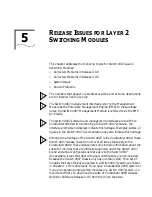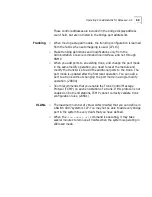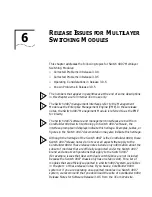
52
C
HAPTER
5: R
ELEASE
I
SSUES
FOR
L
AYER
2 S
WITCHING
M
ODULES
Problem Detail
SNMP applications that query
a3ComSysBridgeVlanPortAddressRemoteAddress
and the other “allClosed VLAN” address table MIBS may cause traffic
slowdowns if issued
asynchronously with multiple variable binds
as
described below:
■
Asynchronous requests — an SNMP request that is sent by an SNMP
program before the previous request has been processed, and
responded to, by the EME in the system.
■
Multiple Variable Binds — SNMP packets should not contain more
than one Get request per SNMP packet. There are no issues with
Synchronous SNMP with one variable bind per SNMP packet.
However, the processing capability of some modules prohibits a timely
SNMP response to the gathering agent, in which case the SNMP
gathering agent will time out and not report any MAC addresses have
been returned by the EME.
Work Around
There is a work around for the issues of timing out while gathering MAC
addresses. That is, you must extend the timeout interval of the SNMP
gathering agent to allow for up to 15 seconds of delay when your
network is using high availability features such as VRRP and MPLA.
Unfortunately, the applications Transcend Address Tracker and Enterprise
VLAN Manager cannot modify their timeout intervals sufficiently to
accommodate the EME, which is the cause of an incomplete number of
MAC addresses returning to Address Tracker.
In some configurations involving MPLA and Closed VLANs, traffic may be
slowed altogether while querying the switch for MAC and IP addresses,
but the device and network do recover smoothly from these instances.
Stability issues have been fixed with respect to proper TCMP processing,
however the return of MAC addresses upon query in these configurations
is slow.
Summary of Contents for 4007
Page 10: ......
Page 32: ...32 CHAPTER 3 RELEASE ISSUES FOR MANAGEMENT MODULES...
Page 64: ...64 CHAPTER 5 RELEASE ISSUES FOR LAYER 2 SWITCHING MODULES...
Page 128: ......
















































